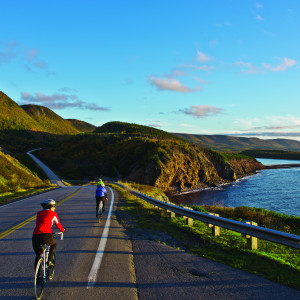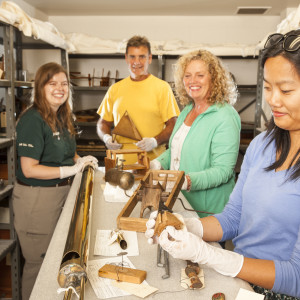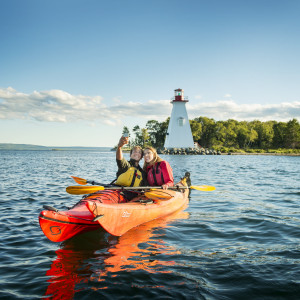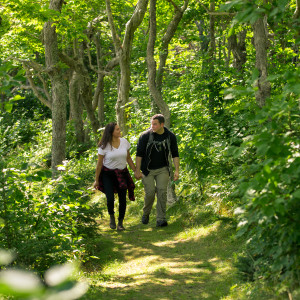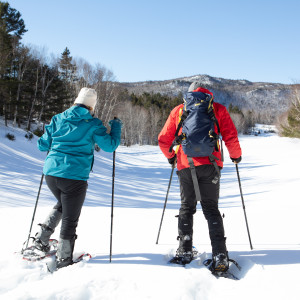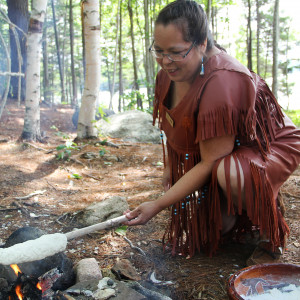When going outside in the cold, you should wear: a hat, a scarf or face-mask, long-sleeves, mittens or gloves, warm socks, long pants, waterproof boots and a warm jacket with a hood.
Life in Cape Breton
With a backdrop like Cape Breton Island you will be inspired both inside the classroom and out.
It’s no surprise that Cape Breton is Canada’s most beautiful island, with its rich, natural beauty and lively culture, Cape Breton is ready to be the backdrop for your next adventure. Located in Mi’kma’ki, the unceded territory of the Mi’kmaw people, our beautiful island has deep roots in Indigenous, Gaelic and Acadian cultures, among others.
With a wealth of activities to participate in year round during all four seasons, fall, winter, spring and summer, the list of things to do is endless. Whether it’s tubing down the Margaree River, snowboarding at Ski Ben Eoin, catching a movie at the Cape Breton Drive In or cruising around the world famous Cabot Trail, the adventures you take part in on Cape Breton Island will be a big part of your student experience.
To get a better taste of places to visit and things to do on Cape Breton Island, visit cbisland.com and explore our virtual tour.
Cape Breton is truly a global community, and has a population of approximately 135,000 that is spread across awe-inspiring land and seascapes just waiting to be explored. With nearly 7,000 students from more than 70 countries around the world, even if you’re travelling from far away, you’re bound to meet many other people who are making Cape Breton their new home away from home.
With stunning views around every corner and magnificent sunsets every evening, you’ll feel grounded in the safety and serenity of campus and its surrounding communities. Cape Breton University is situated within the Cape Breton Regional Municipality, just minutes away from grocery stores, pharmacies, urgent centres and the JA Douglas McCurdy Airport.
So, what’s the weather like?
Well, it’s Canada. So, be prepared to enjoy snowy winters as well as warm, pleasant summers. If you are coming in the winter, we recommend arriving with warm clothing such as hats, gloves, boots and jackets. Can’t find anything like that where you live? Don’t worry, there are clothing stores here where you can purchase what you need to keep you comfortable.
Check out our list of FAQ’s about Canadian Winters to help make the most out of your winter.
Living on Cape Breton Island
Securing housing before arriving in Cape Breton plays a vital role in your student experience. Like most of Canada, affordable housing is a serious issue in Cape Breton. Housing in the area is limited and students should begin their search early. It is dangerous and irresponsible to travel anywhere without planning accommodations.
We recommend living on-campus for your first year of study. To view residence options, visit CBU.ca/residence. If you’re interested in living off-campus, housing listings can be found at CBU.ca/accommodations.
University is about more than just what you study. It’s also about the friends you make, the life lessons learned and the adventures you take. Cape Breton Island is the perfect place to learn and explore.
Frequently Asked Questions About Canadian Winters
To layer clothing means to wear several items of clothing on top of one another to keep you warm. If you enter a well-heated area, you can remove layers to avoid excessive sweating, which can actually make you colder.
Wearing several thin layers of clothing can be more effective at keeping you warm than one large coat.
A toque is what we call a winter hat. Some types have pompoms on the top! A lot of heat can escape through your head, so wearing a toque is a great way to keep warm outside.
A parka is a very warm, heavy winter coat with a hood. Sometimes there is fur or fake-fur around the hood to protect your face from the wind.
Heat escapes your body through your head. By wearing a winter hat, you trap the heat inside, allowing you to stay warm longer.
The average temperature in Sydney in the winter is approximately -4.3° C
If you have a smartphone, you can use the weather app for up-to-date information. You can also visit https://www.theweathernetwork.com/ca or https://www.weather.gc.ca/canada_e.html
If you feel like the temperature inside is too dry, try using a humidifier or placing a plant in your room.
Many people experience dry skin during the winter months. Try to drink extra water, regularly apply cream to your skin and keep lip balm!
Sometimes people don’t feel like themselves during the winter. They can feel more tired than usual, less energetic or a little sad. It may have something to do with the cold weather and having less sunlight. We call this the winter blues.
Making self-care a priority is the best way to keep the Winter Blues away. Make sure you’re getting enough sleep, eating a balanced diet, getting together with friends and spending some time outside. If you suspect your feelings are more serious, you should contact our counselling services at the Nancy Dingwall Health and Counselling Centre.
The weather channel may tell you it’s -15° outside with a wind chill of -20°. This means, when you go outside it will feel like -20° even though it’s really -15°. The wind can make it feel colder outside than the actual temperature.
Black ice is a thin layer of ice that forms on roads and sidewalks in the cold weather. It’s so thin that you can’t see it, but it’s VERY slippery. Be careful when walking on any outdoor surfaces in the winter, take your time.
A blizzard is what we call a very strong snow storm. It often includes lots of snow and very strong winds that make it difficult to see. These storms last longer than a few hours, and it’s usually best to stay indoors during a blizzard.
You may hear a warning about blowing snow, which happens when the wind picks up the light fluffy snow making it difficult to see. When blowing snow is very bad, it can cause “white-outs” which means drivers cannot see and should stay off of the roads.
Freezing rain creates a layer of ice on trees, cars, roads and sidewalks making it very slippery outside. It can feel like a mixture of rain and ice falling, so if you’re going outside in freezing rain you should try to cover your head and protect your face with a hood or mask.
Cape Breton University takes its responsibility to its students very seriously and tries its best to remain open at all times for classes and University business. However, at times, the campus must close to ensure the well-being of our campus community. In the event of a closure, the campus community will be notified immediately through CBU Alert, www.cbu.ca, and our official Facebook and Twitter accounts. A notice will also be sent to local radio stations. You can find information about campus closures and our inclement weather policy here.
Reasons for closure may include inclement (bad) weather, power outages or other unforeseen circumstances beyond our control. For more information, you can view our Inclement Weather policy here.
The busses will stay on the road when it snows unless the roads become dangerous. If the busses are not running, CBU will be closed.
All Canadian provinces recommend that motorists have winter tires installed when the temperature drops below 7° Celsius. Winter tires are designed to grip the road better in slippery conditions.
It is a great idea to have an emergency kit in your car. Things to include would be: food that won’t go bad such as energy bars, water, a blanket, extra clothing and shoes, a first aid kit, a small shovel, a snow-scraper, a candle and matches and a flashlight.
You cannot develop a cold or flu just from being cold, those illnesses are spread by germs. However, if you are outside for long periods of time without the proper winter clothing, you are at risk for developing hypothermia or frostbite which will make you feel sick.
Frostbite is a rare injury to the skin caused by being exposed to very cold temperatures. To keep yourself safe, make sure to protect your hands, feet, nose, ears and face when spending time outside.
Frostbite appears as a whitening of the skin, followed by redness. It may also swell or itch. If you notice these symptoms while outside, go inside and warm up as soon as possible. If your symptoms do not improve after spending some time inside, seek medical attention.
Hypothermia occurs when your body temperature drops below 35° Celsius (95° F). Symptoms can include shivering, numbness and confusion. The best way to prevent hypothermia is to dress warmly when going outside for long periods of time.



